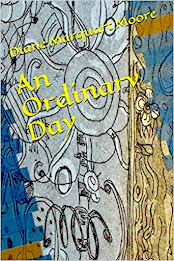Dog lovers will appreciate the photo of the black lab wearing a bright red jacket, head turned toward some sound in a wood of aspen with yellow leaves, that appears on the cover of Pinyon Review #10. The dog’s name is Garcia, and he’s accustomed to proofing manuscripts with Editor Gary Entsminger and Managing Editor Susan Elizabeth Elliott near Montrose, Colorado. Inside "The Castle," the cabin headquarters of Pinyon Publishing, Garcia turns in early after a day of manuscript reading, climbing mountains, dancing to folk music, chasing wildlife, and helping to cultivate his owners’ large garden. Garcia often signs his name to emails addressed to me, and lets me know if my latest poetry offerings to Pinyon Review pass muster with him. I appreciate the attentions of this beautiful dog even though I’m allergic to animal dander and can only admire him from afar.
Poetry lovers will love this issue of Pinyon Review as it’s primarily a collection of poetry from numerous award-winning poets. It also contains an exhibit of the painting/art design work of Susan Elliott. Bonus material is a suspenseful vignette by the editors that reminded me of Red Lights, one of Georges Simenon’s short psychological novels.
I usually attempt to single out a few authors to tout in a review, but the excellent work of sixteen poets in this issue begged me not to discriminate, so I finally decided to focus on a single poem that contained five parts entitled "Arizona Ruins" by Lyn Lifshin. It’s an arresting study of the Sinagua Indians, a tribe that disappeared into the cosmos and whose ruins I visited during a stay in Sedona, Arizona in the summer of 2007. Lifshin writes: "No one knows/where they went/from the cliffs/with their/earth jars and sandals/Or if they/cursed the/desert moon/as they wrapped/their dead/babies/in bright cloth/and jewels…"
On a hot summer day when I visited the ruins and became unbearably thirsty, I felt in sync with the poet who wrote: "Now cliff swallows/nest in the mud/where the Sinagua/lived/until water ran out…" I wondered if the tribe died of thirst or moved to a new watering hole, but a guide told us that they simply disappeared, and I remember writing my own poem about ghosts of these native Americans who sometimes lived on lizards and nuts. "The people left/ the debris of their lives here/arrows, dung/And were buried/with the bright/turquoise they loved/sometimes carved/into animals and birds."
I love the clean lines of this poem and the powerful images it invokes of people struggling for survival, making stone jewelry and braiding willow stems in the Arizona desert. I blinked when I read a biography of the author who lays claim to writing over 130 books —that fact is the entire bio, which is as mysterious as the poem about the Sinagua, and I respect the privacy of the creator of such powerful imagery.
From start to finish, readers are held in suspense with Gary and Susan’s "Where Was I? —for Tom Martinez," a story about a man who wandered onto the couple’s property, lost, after sunset, one evening. The man had been harvesting pine nuts in the pinyon-juniper woods and had gotten turned around, and in the vignette Gary offers to drive him back to his car via Government Springs in exchange for half his harvest of pine nuts. Gary writes that since pine nuts from Colorado, Nevada, and New Mexico are almost impossible to buy, except in a Chevron station in Austin, Nevada, he agreed to make the drive while Susan stayed home and fretted about him driving in the dark to Martinez’s home on the rim of a canyon. It’s a good spin about a repeat incident Gary experienced lending a hand to a lost neighbor who claims his wife’s legally blind and he’s legally insane. Gary and Susan have jointly written several books that include Ophelia’s Ghost, Fall of ’33, and Remembering the Parables.
Also in this issue of Pinyon Review is a stunning, blue-green watercolor entitled "Sea Quilt, 24"x36" in which Susan used watercolor, ink, and thread on 140-lb. cold-pressed watercolor paper. She writes: "On quiet winter morning walks when I pause and gaze across snow-covered fields of sagebrush, I sense the ocean in the stillness. The other dimension laps at my ear like the hum of Om."
Garcia highly recommends Issue #10 of Pinyon Review and donned his red coat especially to attract readers... or perhaps, in honor of Thanksgiving, he wanted to rustle the feathers of the wild turkeys that often come to breakfast at "The Castle." Copies of this issue can be ordered from Pinyon Publishing, 23847 V66 Trail, Montrose, CO 81403.





















